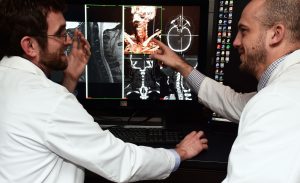Although you may never meet your radiologist, they are dedicated to making sure you receive the best possible health care treatment. Your radiologist at UVA is a medical doctor (MD) who went to medical school, completed a four-year residency in radiology, and then completed a one- or two-year specialized fellowship.
What a radiologist does
A radiologist is a doctor who works behind the scenes to interpret, or read, medical images in order to diagnose and treat diseases or injuries. Radiologists use images from X-rays, CT, MRI, ultrasound, PET, or nuclear imaging examinations to recommend the next steps in your care, whether that be for more examinations or treatment.
A radiologist also determines the type of imaging exam that should be used (X-ray, CT, MRI, etc.), helps referring physicians select the best forms of treatment, and creates radiology reports for other doctors involved in your care. Some of our radiologists, known as interventional radiologists, can even use imaging guidance to perform minimally invasive procedures that replace conventional surgery.
Why is radiology the key to your care?
Radiology is the means by which doctors see and understand what is happening inside your body, so having a qualified radiologist is crucial to the quality of your health care.
“The explosion in knowledge and technology in modern medicine has completely transformed the concept of clinical diagnosis and treatment as practiced before,” said Director of Ultrasound Dr. Rachita Khot. “These changes along with the advent of modern imaging tools has made [radiology and medical imaging] the definitive diagnostic tool for many diseases, as well as a very important role in monitoring treatment and predicting outcomes.”
Specialized, accredited radiologists deliver the best diagnosis quickly, and it is likely you’ll need the services provided by a radiologist at some point in your life.
“Most if not all patients interact with radiology in one way or another, either in the process of disease screening, diagnosis, intervention and follow up,” added Dr. Khot.
Why are UVA’s radiologists especially qualified?
At UVA, all of our radiologists have completed fellowship training. A fellowship is an additional one to two years of highly specialized medical education in a subspecialty area of radiology such as abdominal (chest, abdomen, or pelvis) or musculoskeletal (muscles, bones, and joints) imaging.
To see why a fellowship is important, imagine that your car is having a major problem with its engine, and you have the choice between two mechanics. The first mechanic is very knowledgeable in diagnosing and repairing all types of vehicles. The second mechanic completed the same training as the first mechanic, but he also completed an in-depth apprenticeship studying how to diagnose and repair the specific make of your car. Which mechanic would you want to take your car to?
Just as you might consider the second mechanic an expert in the make of your car, a doctor who studies images of one part of the body during their fellowship becomes an expert in interpreting those images.
You have a choice
Most people don’t realize that when it comes to having your imaging examination, you have a choice. When your physician recommends you have a medical imaging exam, you can suggest and ultimately choose where. Talk with your physician about why you want to have your imaging done at a specific place. After all, you both share the goal of making sure you receive the best health care available.
The UVA Health System is dedicated to bringing you the best care. You can learn more about Radiology and Medical Imaging at UVA here. You can also learn more about radiologists and the work they perform from the American College of Radiology or this website for radiology patients.



A radiologist has to constantly upgrade himself with technology and he has to be more patient-centric to become successful. Diagnostic Radiology as a subject has gained huge importance in the recent years with the increase in cancer-related treatments.
Great read! Interventional radiologists take imaging technology a step further by using it to treat certain diseases and conditions. These professionals create electronic maps to guide their instruments as they insert catheters, remove malignant tissue and perform other delicate procedures. This gentle approach allows patients to recover faster and with fewer complications.
What undergraduate degree major and minor should a prospective Radiological MD pursue?
very clearly describe what is a radiologist and it si quite easy to understand by reading your post thanks for sharing this it is very helpful.
Great read!! thanks for sharing such a great blog.
Great read!!! Thanks for sharing such a great blog.
Great post! Radiologists play a crucial role in healthcare by providing important diagnostic information that helps guide patient management and treatment decisions. They work closely with other physicians and healthcare professionals to ensure accurate diagnoses and effective patient care.